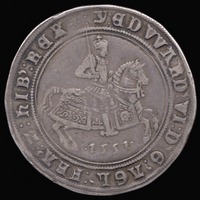
First Silver Crown

This site deals with the Crown coins issued by Britain and by her
Colonies, Territories, Protectorates, etc. This particular denomination was worth
five shillings which for a lot of its history was equivalent to one-quarter of a pound/sovereign. When decimalization came,
the shilling was demonetized and 100 pence made up a pound. The twenty-five pence piece (one-quarter of a pound) is still
referred to as a crown and is included here.
The first crowns were of gold and struck under the name of a half-ryal (equivalent to 5 shillings and weighing 60 grains)
in the first reign of Edward IV (1461-1470). No further coins of this denomination were struck until the reign of Henry
VIII in about the year 1526. These were 22 carats fine and weighed 57 21/57 grains. His later crowns dropped in fineness
to 22 or 20 carats and weighed only 48 grains.
The first issue of Edward VI (1546 to 1553) was of similar weight and fineness. His subsequent issues were of restored
fineness but the weight was further diminished. Elizabeth I (1558 to 1602) issued crowns which were initially valued at
3s 4d. Later in her reign (1592 onwards) they were once again valued at five shillings. The weight had stabilized at
about 43 7/11 grains of 22 carat fine gold.
James I (1603-1625) issued crowns or quarter-laurels valued at five shillings. Additionally he issued Britain Crowns and
Thistle Crowns which were of varying values. The former being 5s or 5s 6d and the latter being 4s or 4 ¾d His crown
was slightly less than the preceding, and nominally weighed 42 66/67 grains, with the Britian Crown, Quarter-Laurel, and
Thistle Crown weighing significantly less, though of the same 22 carat fineness. Charles I (1625 to 1648) also issued the
Britain Crown, and his was worth five shillings and weight 35 5/41 grains of 22 carat fine gold. This coin was continued
in the Commonwealth (1648 to 1660) at the same standard and weight. The last gold crowns were struck during the first
coinage of Charles II (1660 to 1684).
The first silver crowns (which are mainly what is dealt with on this site) were struck by Edward VI in 1551. These are also the
first English coins dated in numerals.

First Silver Crown